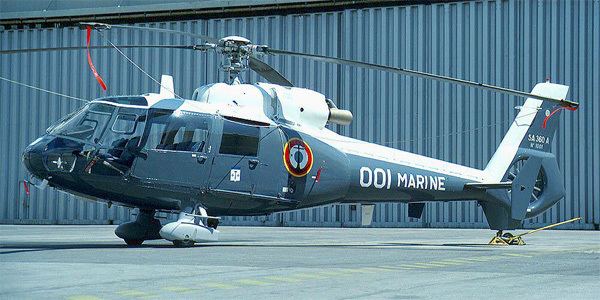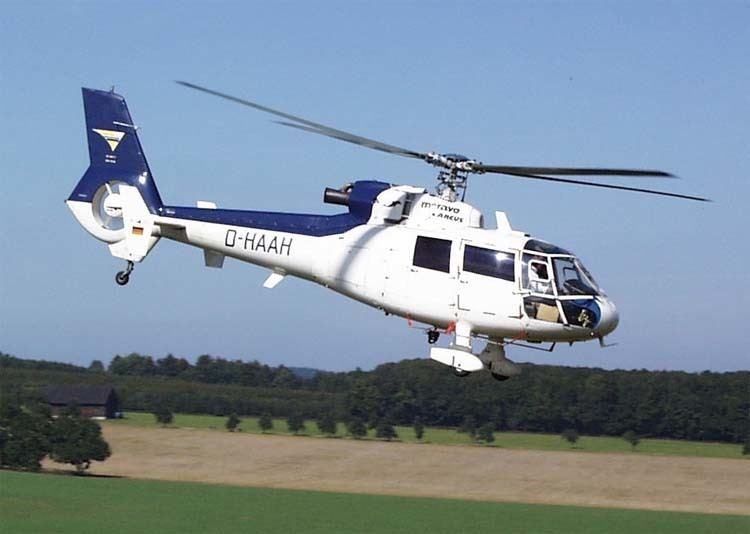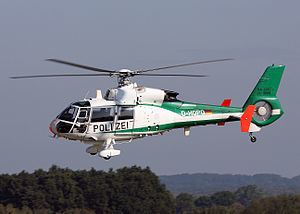Top speed 315 km/h Length 13 m | Wingspan 12 m First flight June 2, 1972 | |
 | ||
The Aérospatiale SA 360 Dauphin was a single-engine French utility helicopter developed as a replacement for Aérospatiale's Alouette III in the early 1970s and to fill a gap in the company's product line in the six to ten-seat helicopter category. However, as the new helicopter offered little advantage over its predecessor and thus limited market appeal, production of the SA 360 Dauphin was abandoned after only a few dozen of them had been built.
Contents

Aérospatiale had also developed a twin-engine derivative, the Dauphin 2, which proved to be quite successful and has been in production for nearly 40 years. After the merger of Aérospatiale's helicopter division into Eurocopter in 1992, the Dauphin 2 designation was dropped, and Eurocopter-built Dauphin 2s are simply referred to as "Dauphin". The retronym "Dauphin 1" is sometimes applied to the original Dauphin.

Design and development

The Dauphin design was originally derived from the Alouette III it was intended to succeed, and in fact used the rotor blades from that aircraft. Power was provided by a 730 kW (980 hp) Turbomeca Astazou XVI turboshaft, in place of later Alouette IIIs' Astazou XIV. The aircraft featured a fully enclosed cabin with seating for up to nine passengers, a four-bladed main rotor and a thirteen-bladed fenestron in the tail. It was fitted with fixed, tailwheel undercarriage with spatted mainwheels. The first of two prototypes (registration F-WSQL) made its first of 180 test flights in this configuration on 2 June 1972.

Following this initial evaluation, a number of modifications were incorporated into the design. These included increasing engine power by use of an Astazou XVIIIA of 780 kW (1,050 hp), and replacement of the original rotor blades with plastic blades. Aérospatiale engineers hoped to reduce vibration and ground resonance. Thus modified, test flights resumed in May 1973, in time to present the new aircraft at that year's Paris Air Show. In the meantime, a second prototype (registration F-WSQX) joined the test programme, flying first on 29 January. At the show, the first prototype broke three world airspeed records for helicopters in the 1,750 kg - 3,000 kg class (FAI class E-1d). Piloted by Roland Coffignot and carrying a dummy payload to represent eight passengers, it broke the 100 km closed-circuit (299 km/h, 186 mph), 3 km straight-course (312 km/h, 195 mph), and 15 km straight-course (303 km/h, 189 mph) records.

Series production of the definitive SA 360C version began in 1974, with the first completed aircraft flying in April 1975. French civil certification was obtained in December that year, and deliveries to customers commenced in January 1976. In the meantime, Aérospatiale had flown the prototype Dauphin 2 nearly a year earlier, on 24 January 1975, which would ultimately prove the death-knell for the Dauphin. A helicopter of this size powered by only a single engine was perceived in the marketplace as something of an anomaly and rather under-powered, meaning that by the end of 1976, Aérospatiale was left with 15 airframes - almost half those produced to date - with no buyers. Accordingly, production was terminated the following year.

A single airframe (Construction Number 1012, registration F-WZAK). was modified by Aérospatiale from standard SA 360C configuration to develop a version optimised for hot-and-high conditions, designated SA 360H. The main differences were the use of a 1,040 kW (1,400 hp) Astazou XXB engine and the Starflex rotorhead that had been developed for the Ecureuil. Deciding that the main customers for this more powerful aircraft were likely to be military ones, the aircraft was further modified and re-designated SA 360HCL (Helicoptere de Combat Leger - "Light Combat Helicopter"). It was fitted with a SFIM APX M397 roof-mounted, gyro-stabilised sight, and a nose-mounted sensor package incorporating a SFIM Vénus night-vision system and TRT Hector thermal-vision system. Armament consisted of eight launcher tubes for Euromissile HOT missiles, with options to carry most of the armament packages used by the Gazelle. So equipped, it could carry thirteen combat-ready troops into battle, or be used in the area neutralisation or anti-tank role. This aircraft was taken on by the Armée de Terre for evaluation, but no production order ensued.
Variants
Operators
Notable accidents
Specifications (SA 360C Dauphin)
Data from To the throne...on its third try
General characteristics
Performance
